The Power of Great Content: Write Your Way to Superior Brand Awareness
November 15, 2022
Excellent brand awareness is essential for business growth, and the key to driving high levels of brand awareness is implementing a robust content marketing strategy. As the title of the research paper by Müller and Christandl 2019 suggests, “Content is king, but who is the king of kings?”
Different businesses have different marketing requirements. With a whole spectrum of content options available, it can be tricky to decide which medium is the most appropriate for growing visibility in your target audience. You may even find a hybrid content strategy to be the perfect impetus for achieving your visibility goals.
Let’s look at the concept of brand awareness and how it can be molded and transformed with the main content mediums, respectively.
What is brand awareness?
Brand awareness is a fairly straightforward concept. According to Oxford Languages it simply means:
The extent to which consumers are familiar with the qualities or image of a particular brand of goods or services.
The simplicity of this concept, however, should by no means overshadow the possibly detrimental consequences of not getting it right. Most markets in the U.S. today are mature, which is forcing businesses to compete at levels never seen before and to create unique business identities and personas in order to stand out from the crowd.
When asked how important brand awareness is, Etienne de Jager, Managing Director of University College Roosevelt (UCR) in the Netherlands, said, “Not being visible or having a brand identity is much like being a library book without an index number. You may have the best book cover, but what does that help if no one can find it to read? Simply put, without brand awareness you are invisible.”
Apart from the occasional impulse buy, most customers are far more likely to buy your products or use your services if they are familiar with your brand. Customers usually look first at your website, social media, and any online reviews to give them an idea of your consumer reach and the quality of your products or services.
There are two ways to assess brand awareness.
Unaided Brand Awareness
This method measures how many people in a segment of the population express knowledge of your brand without a direct prompt. This is also referred to as ‘brand recall’ because you are measuring how many people recall your brand without an explicit prompt, i.e., not giving any indication of your company name. For instance, If your business sells business cards, you may formulate a question such as: “What company will you use to print your business cards?” If you pose this question to 100 people and 25 people mention or recall your company as one of their preferred printers, then you have a 25% brand awareness.
Aided Brand Awareness
This method measures brand recognition by using a direct prompt such as a list of companies, including yours, to see how many people recognize your brand from the list. A typical aided brand awareness question may be: “Which of the following printing companies are you familiar with?”
Both aided and unaided brand awareness initiatives can be conducted through a mix of open-ended and closed-question surveys.
What is content marketing?
Content marketing is a component of inbound marketing and is arguably one of the most effective methods to drive traffic to your platforms, increase your brand awareness, and generate meaningful leads. The Content Marketing Institute suggests:
“Content marketing is a strategic marketing approach focused on creating and distributing valuable, relevant, and consistent content to attract and retain a clearly defined audience — and, ultimately, to drive profitable customer action.”
The institute asserts that traditional marketing techniques are becoming less effective, and a more forward-thinking approach is now more critical than ever. Whereas traditional marketing focuses on explicit ads describing your products or services, content marketing provides your customers with relevant, interesting, and useful information which indirectly relates to your business.
For instance, in addition to creating an ad for a specific kind of business card paper quality, you may also want to publish an article on your website blog about all the different kinds of paper used in business card printing, pointing out the advantages and disadvantages of each. This article will engage your audience, ensure they spend more time on your platforms, and ideally get a couple of items in their shopping carts.
Holding a bachelor’s degree in marketing, and two master’s degrees, de Jager has a strong professional and academic marketing background and has held multiple senior marketing roles in London and the Netherlands. He adds, “Blogs allow businesses to make relevant connections with products, services or any topical discussions, and it still remains one of the most effective tools to optimize the value of your SEO.”
Below are seven steps put forward by the Content Marketing Institute to consider when you start planning your content strategy.
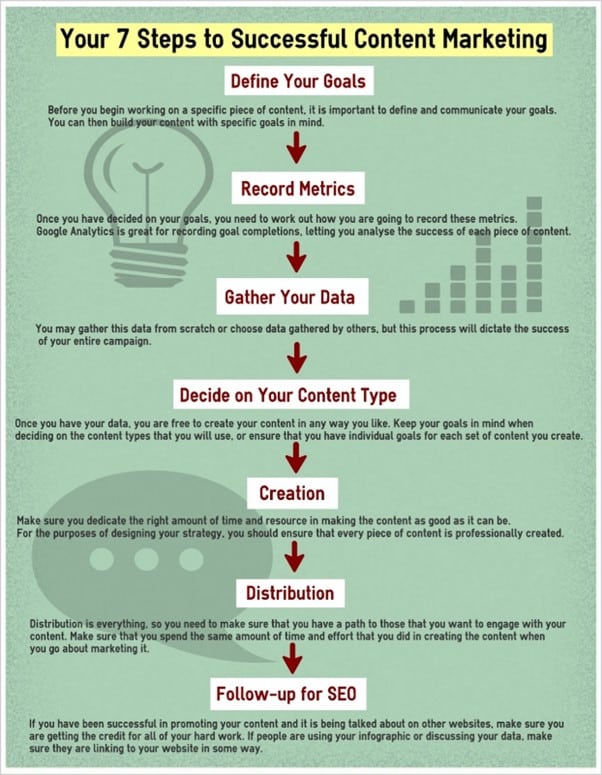
Let’s look at the main content mediums in more detail.
1 – Blog Posts and Articles
The blog can be traced back to 1994 when Justin Hall posted the first blog ever on links.net, which he referred to as his home page because the term “blog” had not yet been coined. Traditional blogs were personal online collections of thoughts, information, and opinions published on various platforms.
Today, almost every business imaginable is also blogging because of the unique way this medium provides to promulgate information to their customers in a more informal and relaxed tone, not to mention the various other marketing and financial benefits.
According to medium.com, blogging is the most effective type of content marketing because its main objective is to increase brand awareness by providing accurate information and optimizing your website through brand-relevant content that also supports SEO (Search Engine Optimization). So, what else is blogging good for?
Website Traffic
Most business marketers agree that blogging is the best medium for generating web traffic and, according to a Hubspot study, it can lead to a 55% increase in traffic. In addition, companies that blog on a regular basis grow their inbound links and indexed pages exponentially.
Whenever you publish a new blog article, you create a new web page, which is then indexed by various search engines. This means that you literally grow your online presence with each new page and therefore increase opportunities for customers to find you. In addition, frequent blogging shows the likes of Google and other search engines that your website is active and updated regularly.
Lead Generation
If your main blogging goal is lead generation, then every blog post you publish should give your site visitor the opportunity to interact. This is called a call-to-action and comes in many shapes and sizes. You may add a “sign up to mailing list” button for special offers, or perhaps offer a free webinar or other content assets. Call-to-action lead generation is one of the most effective ways to build a client contact database and is the most ethical way to build your direct email list.
Link Building
Link building or “backlinks” is one of the most crucial factors for Search Engine Optimization. That said, link building is extremely challenging. Backlinks are essentially other businesses that link a page on your website to their website. This means that some of the traffic from that business’s website can be diverted to your website, and, if that business ranks high on Google and they have associated with your business by sharing your link to their site, your site ranking will also increase by default.
Your best chance to grow your backlink presence is by ensuring your content is factually accurate, unique, and of the highest quality. Reputable businesses have online authority, so they are cautious about whom they associate with and what content they publish or share.
Other Benefits
As opposed to Google or any other online ads, a blog post or article is more cost-effective because there is no time limit for how long it remains published. Whereas you might buy and run an ad for one week, your blog post stays published online and works 24/7, attracting visitors at all hours of the day. Ads can also be a nuisance as opposed to informative blog posts that people search for and actually want to read.
2 – White Papers and E-books
The white paper has become a well-known term in recent years, and there are many different types of white papers used in both the public and the private sectors. We will focus on the latter. According to Investopedia:
“A white paper is an informational document issued by a company or not-for-profit organization to promote or highlight the features of a solution, product, or service that it offers or plans to offer.”
In business, white papers are used as sales and marketing documents to describe in considerable detail any new products, technologies or methodologies, and services. One of the most well-known, influential, and popular white papers published in recent years is the Bitcoin white paper by Satoshi Nakamoto, which instantly attracted global attention.
White papers are usually at least 2500 words in length and written in a more formal academic style. A white paper must be written by an authority on the subject and should aim to educate readers about the topic, with the ultimate goal of generating sales. A white paper is a sales pitch but not in the traditional sense, as it is much more formal and includes the following:
Introduction
Regardless of the topic, all whitepapers must have an engaging introduction that sets the tone for the rest of the paper. This is your opportunity to convince the reader to read the entire document.
Problem
Here you should articulate the particular problem your product or service can resolve. You will need to demonstrate that you have a comprehensive grasp of this problem and describe in detail how this problem can affect the reader negatively. The more convincing and relatable this section is, the more likely you will generate sales.
Solution
This section must describe how or why your product or service is the best solution to the above problem. The more detail you provide in this section, the more convincing your white paper will be. Just be careful not to oversell as you may lose the reader’s interest.
Conclusion
The conclusion section gives you the opportunity to summarize the main points of the problem and solution sections and is your final chance to motivate the reader to buy into your business and your products or services. An effective conclusion will also contain a call-to-action that tells the reader what to do if they are interested in your products or services.
White papers are a great public relations tool to help you generate interest in your business, establish credibility, generate sales, and increase engagement.
Similar but less formal than white papers are e-books, a type of long-form content medium businesses can publish and offer to their customers as either free-of-charge or paid downloadable media. E-books have gained a lot of momentum and are a great marketing tool businesses can use to accomplish the following:
- Translate complex information into a simple, easy-to-understand medium for customers
- Establish themselves as an authority on the products or services they offer
- Grow brand awareness and drive traffic to their websites
- Generate leads
- Build trust and brand loyalty
- Educate customers on their products or services, and wider issues relating to their industry
- Organically grow email lists
3 – Email
Unbelievably, email marketing is celebrating its 44th birthday this year, tracing back to 1978 when Gary Thuerk sent out the very first mass email to around 400 recipients in the days before the term junk mail had been coined. According to Thuerk, this first mass email generated an astronomical $13 million in sales revenue. Needless to say, email marketing has come a long way since 1978. Most notable are the legal and data protection measures authorities have implemented to protect everyone from nuisance and scam emails.
Nonetheless, ethical email marketing still remains one of the most effective tools when executed professionally. With an estimated 306.4 billion emails sent daily across the globe, it would be foolish for any business not to invest in an email marketing campaign. As the graph below by marketinginsidergroup.com illustrates and compares, email marketing’s return on investment is quite lucrative:
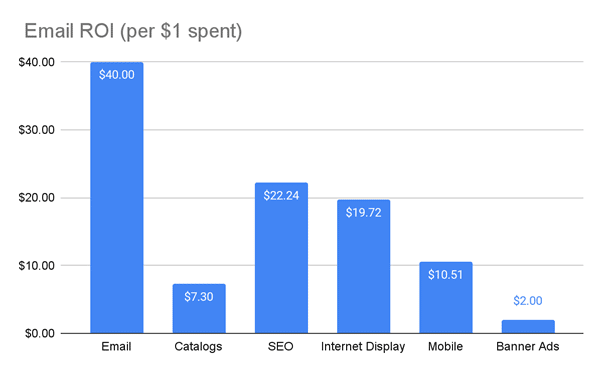
What else do the stats say?
According to HubSpot, email is listed as one of the top three most effective marketing mediums by 79% of marketers. Eighty-seven percent of e-commerce marketers primarily use email marketing to increase brand awareness, and email visitors are the most likely to convert on forms. Thirty-one percent of B2B marketers is convinced that regular email newsletters are most effective at nurturing leads. Lastly, about 60% of e-commerce, retailers, and consumer goods businesses personalize emails to their customers based on previous purchases.
Build your email list and set goals.
Before you embark on an email marketing campaign, first ensure that you have a decent-sized mailing list made up of customers who voluntarily signed up on your platforms. Depending on the size of the business, most e-commerce brands have between 1,000 and 10,000 email contacts. Bear in mind that buying email lists is not only illegal, but it is also unethical and frowned upon. There are thousands of online sources which can help you build an email list ethically.
Once you have your mailing list, you should define what you want to achieve with your campaign. Some goals could be:
- Increasing brand awareness
- More web traffic
- Lead generation and sales
- Feedback or surveys
- Referrals
- Promoting your blog, e-books, or whitepapers
- Informing customers of special offers such as newsletters
Target your campaign.
Here it’s all about working smarter, not harder. An effective email campaign should be tailored to the individuals it is being sent to, based on their geographics, demographics, psychographics, and behavior. As illustrated by the www.superoffice.com graph below, a good approach is to use data and analytics from past campaigns to help inform your segmentation process:
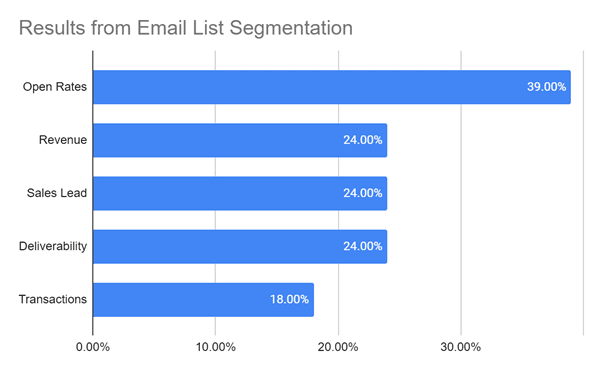
Persuasive Content Creation
Your content will determine how effective your campaign will be, so keep the following in mind:
- The headline makes the first impression; keep it catchy and enticing.
- Create attractive and inviting content with lots of white space.
- Humor is great for grabbing someone’s attention.
- Add the customer’s first name in the subject line or greeting.
- Convey a clear and to-the-point message; don’t waste the reader’s time.
- Personalize the email as much as possible.
- Ensure the email is mobile friendly.
- Don’t send too many emails, as you may get unsubscribed.
4 – Infographics

Infographics, as the name suggests, are visual representations of data and information with the aim of informing, educating, and building brand awareness through a data-rich visualization of a story.
The infographic to the left, by Business 2 Community, provides a brief overview of the history of the infographic, and is a great example of one.
So, why have infographics become so popular?
The real question should be: Why aren't they popular? The list will be much shorter.
According to Martech.zone, the visual aspect plays a key role in the rise in popularity of infographics, as 90% of the information our brains retain is visual, and studies have found that humans only retain between 10-20% of written or spoken information as opposed to 65% of visual information.
Infographics are also great for generating backlinks, as businesses are more likely to share visual aids on their websites.
In addition, humans process visual information much faster.
A well-designed infographic can simplify complex information into easily digestible visual aids. For instance, we follow directions such as road signs around 323% better with visual aids than without.
Infographics usually include company logos and branding, which is a great tool to build brand awareness. People also tend to spend more time reading visual content than just plain text. With the right call-to-action incorporated, infographics can increase lead generation greatly.
What to Consider When Designing a Good Infographic
As the image below by infogram.com illustrates, there are broadly four areas you should pay close attention to: data, design, story, and shareability.
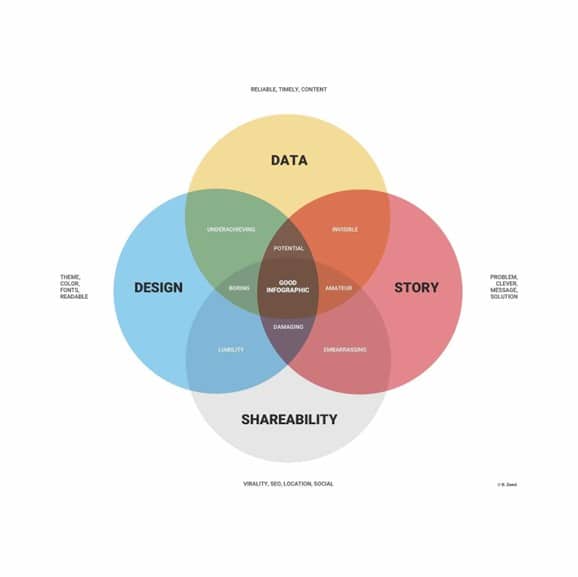
The most imperative aspect when designing an infographic is to make it informative but keep it simple at the same time. Forbes lists the following 12 ways to use infographics effectively in marketing:
- Keep it simple and to the point.
- Amplify true customer stories.
- Explain complex concepts.
- Showcase the strength behind numbers.
- Start from scratch.
- Focus on transmitting intelligence.
- Make complicated topics more digestible.
- Include precise messaging.
- Visually represent trends.
- Weave smaller ones into blog posts.
- Turn data into a visual story.
- Optimize your image data for search engines.
5 – Video and Social Media
According to guinnessworldrecord.com, the very first TV ad by Bulova Watches aired on July 1, 1941, on the U.S. channel NBC just before a baseball game. It was an instant success:
Bulova: world’s first television advertisement.
Today, video marketing still remains the backbone of terrestrial TV and has infiltrated all corners of the internet. In fact, more than half of Twitter’s ad revenue is generated through video ads. Marketers in all industries love video, as it is undoubtedly the king of all kings, with around 86% of all businesses using it, according to Wyzowl.com. As the graph by Wyzowl’s State of Video Marketing Survey illustrates, the use of video as a marketing intervention by all businesses has increased by 25% since 2016.
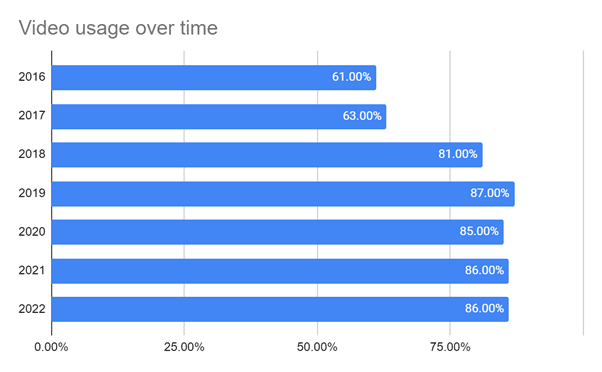
So, why do marketers love video?
People love to watch videos,which is evidenced by the approximately one billion videos watched on Youtube each day. Video as a medium has the ability to give us the information we want quickly and easily. Dreamgrow.com lists eight reasons why video marketing is so effective. It’s really quite simple:
- Video boosts conversions and sales.
- Video offers a great return on investment.
- Videos can build trust.
- Google loves videos.
- Mobile users love videos.
- Video marketing can explain everything easily.
- Video engages customers who don’t like to read.
- Videos are more likely to be shared on social media.
When it comes to video marketing, de Jager says:
How to Create Great Content for Social Media
Having a strong social media profile is critical for all businesses in 2022 because it allows the business to grow its visibility and to communicate and interact with its consumers. With around 2.3 billion active Facebook users, the direction of travel for marketing intervention is crystal clear: The number one most effective way to connect with your audience on social media is through quality content in a variety of media.
Grin.co has a few suggestions, starting with the idea that sharing positive news and statistics may be the key to building trust with your audience, as this can lead to a positive association with your brand. Partnering with social influencers can also be a great way to create authentic and engaging content; they have millions of followers you can reach instantly.
Doing something good for the community and sharing your philanthropic endeavors on social media makes for quality content, is a great way to get your audience’s attention, and may get you a few shares and re-shares. Content that is too in-your-face “salesy” does not go down well on social media. Keep it fun, personalized, relatable, and interesting.
People love getting free stuff and a freebies campaign on social media can’t go wrong. The opposite is true, however, for posts with controversial topics, so be very careful. Lastly, it is definitely worth doing some research on what makes content sharable.
I’m too busy to create my own content. What do I do?
The simple answer is to hire a writing agency. Although most people have the ability to create fantastic marketing content for their own businesses, the reality is that the content creation process is not only extremely time-consuming but is also very labor-intensive. Other benefits of hiring a writing agency include the expertise, knowledge, and speed with which the agency can develop your campaign. Finally, as the client, you have a lot of scope in working with the agency to mold the final product.
De Jager insists: “As a business, you have to invest heavily in your content creation. In most cases, companies do utilize external experts to take on the heavy burden of content creation, giving them more time to focus on the bottom line.”






























